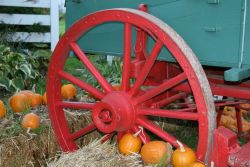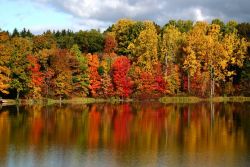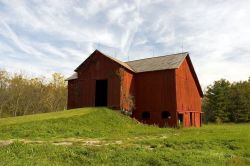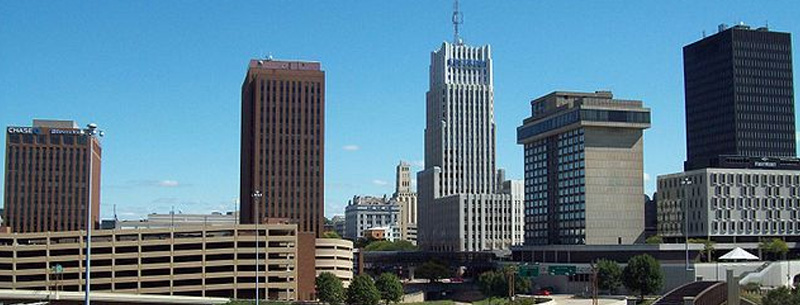2025 Akron Visitors Guide
Founded in 1825, “The Rubber City” is considered in the Top 100 list of the largest cities in the United States. Located between Cleveland to the north and Canton to the south, Akron lies below the Western Reserve in northeastern Ohio on the Cuyahoga River, approximately 60 miles west of the Pennsylvania border.
The census of 2000 indicated there were 217,074 people residing in the city. In 2004, Census Bureau estimates for Akron placed the population at 212,179. The racial makeup of the city was 67.22% White, 28.48% African American, 0.26% Native American, 1.50% Asian, 0.02% Pacific Islander, 0.43% from other races, and 2.07% from two or more races. Hispanic or Latino of any race was 1.16% of the population.
The median income for a household in the city was $31,835, and the median income for a family was $39,381. The per capita income for the city was $17,596.
Akron Attractions
The Akron Zoological Park is home to more than 700 animals including the endangered Humboldt penguins, snow leopards, Sumatran tigers, jaguars, and Komodo dragons. Nestled in the Cuyahoga Valley National Park, the renovated Conrad Botzum Farmstead provides a respite from the hectic 21st-century lifestyle. Seasonal activities and events promise something for everyone including a summer concert series and fall hayrides. The Akron Art Museum is the leading museum of modern art in Northeast Ohio. The museum displays regional, national, and international works dating from 1850 to the present.
 The Akron Police Museum features historical photos, uniforms, and weapons. Other unique items on display include the keys to the original 1890 jail and a 1965 Harley Davidson police motorcycle. A trip to the “Rubber Capital of the World,” wouldn’t be complete without a trip to the Goodyear World of Rubber museum. Learn how Charles Goodyear discovered the vulcanization process, as well as how rubber is made today. The TV Dinner Club Museum houses thousands of artifacts of mid-20th century American TV that dazzle visitors, including television sets, TV-themed memorabilia, and a vast array of items celebrating the small screen.
The Akron Police Museum features historical photos, uniforms, and weapons. Other unique items on display include the keys to the original 1890 jail and a 1965 Harley Davidson police motorcycle. A trip to the “Rubber Capital of the World,” wouldn’t be complete without a trip to the Goodyear World of Rubber museum. Learn how Charles Goodyear discovered the vulcanization process, as well as how rubber is made today. The TV Dinner Club Museum houses thousands of artifacts of mid-20th century American TV that dazzle visitors, including television sets, TV-themed memorabilia, and a vast array of items celebrating the small screen.
The National Inventors Hall of Fame features hands-on interactive exhibits and displays, each encouraging visitors to explore the ideas of discovery, creativity, and invention. Also featured is the Hall of Fame showcases of hundreds of inventors who have significantly changed our lives for the better.
Akron Recreation
The 8,600-acre Summit County Metro Parks system offers 13 parks, a 33.5-mile Bike and Hike Trail, 13 miles of Ohio & Erie Canal Towpath Trail, and the F.A. Seiberling Nature Realm. The historic Cascade Locks Park Association spans Locks 10-16 of the Ohio & Erie Canal and is a must-see for trail users and history buffs alike.
 Named for the founder of Goodyear Tire and Rubber Company, the F.A. Seiberling Nature Realm is a 100-acre nature center that features a 16-acre arboretum with a collection of more than 300 varieties of trees and shrubs.
Named for the founder of Goodyear Tire and Rubber Company, the F.A. Seiberling Nature Realm is a 100-acre nature center that features a 16-acre arboretum with a collection of more than 300 varieties of trees and shrubs.
The Akron Aeros, a Class AA Affiliate of the Cleveland Indians, play in Canal Park Stadium in Downtown Akron while the Rubber Bowl stadium is home to the University of Akron’s football team, the Zips.
Akron Arts
The Akron Symphony is a professional orchestra that performs 7 Classic Series concerts, 3 Family Series concerts, 4 Sundays at the Elms chamber music concerts, Concerts for Kids preschool concerts, free Picnic Pops in the Parks concerts, and a popular Gospel Meets Symphony concert. For more than 118 years, the Tuesday Musical Association has been bringing audiences the most brilliant and exciting soloists and ensembles performing today.
Located on 800 naturally wooded acres, the architectural award-winning Blossom has been a northeast Ohio tradition for great concerts for over 30 years. Some of the hottest entertainers such as Jimmy Buffett, James Taylor, Dave Matthews Band, and Pearl Jam have performed for audiences at the venue under the stars.
The Ohio Ballet, known as one of the finest professional ballets in the U.S., offers a series of free summer outdoor performances in Akron area parks and other parts of northeast Ohio.
Akron Dining
Once an active rubber hub, Akron has transitioned to an economy based on liquid crystal and polymer research, development, and technology. More than 400 companies in the area work on one aspect or another of polymers, creating what is now referred to as “The Polymer Valley.”
The Goodyear Tire and Rubber Company and FirstEnergy, both Fortune 500 companies, are headquartered in Akron. The City is also home to a number of smaller companies such as Gojo, Advanced Elastomer Systems, FirstMerit Bank, Sterling Inc., Roadway Express, Lockheed Martin, and Maritime Systems & Sensors division.
Communities in Akron
Akron has 21 distinct neighborhoods including Lane-Wooster, Chapel Hill, Merriman, Downtown, Middlebury, East Akron, North Hill, Elizabeth Park, Northwest Akron, Ellet, Rolling Acres, Fairlawn Heights, South Akron, Firestone Park, Summit Lake, Goodyear, University Park, Highland Square, Wallhaven, Kenmore, and West Akron.
 Chapel Hill, located in northeast Akron, is a large commercial district bordered by Cuyahoga Falls to the north and Tallmadge to the east. Single and multi-family residential use is dominated north of Tallmadge Avenue. Its many smaller homes and numerous apartment complexes make the area an affordable option for couples. A large percentage of Chapel Hill residents are under 45 years of age. Additionally, the neighborhood has a higher proportion of elderly residents.
Chapel Hill, located in northeast Akron, is a large commercial district bordered by Cuyahoga Falls to the north and Tallmadge to the east. Single and multi-family residential use is dominated north of Tallmadge Avenue. Its many smaller homes and numerous apartment complexes make the area an affordable option for couples. A large percentage of Chapel Hill residents are under 45 years of age. Additionally, the neighborhood has a higher proportion of elderly residents.
Ellet is physically separated from the other neighborhoods by Highway Interstate 76, a river, and an airport. Situated at the far eastern edge of Akron, it borders Mogadore to the east and Springfield Township to the south and includes many of the City’s major attractions including the University of Akron’s Rubber Bowl. The neighborhood includes substantial single-family residents with one in twelve houses being built after 1990.
The Elizabeth Park Valley was developed around the old Ohio & Erie Canal in the mid-1800s and is located within walking distance downtown. The area has retained its canal-era small-town appeal with many people having old canal locks situated in their backyards.
The brainchild of Harvey S. Firestone, Firestone Park, has continued as a highly visible tribute to its creator. The community is a strong mix of educated working-class people with good incomes and home values. Firestone is easily accessible via t Interstate 77 and Interstate 277 / U.S. Highway 224.
Goodyear Heights, another community conceived and built by a rubber baron, was a model of early 20th-century industrial community development. Today, it remains an overwhelmingly single-family residential community with a neighborhood-level retail development at Six Corners. The majority of the housing was constructed between 1940 and 1980. Recently, the city has begun buying up land to build new developments.
Highland Square is a pleasant residential area where famous residents such as John S. Knight, Senator Charles Dick, presidential candidate Wendell Willkie, industrialist Paul Litchfield, and AA founder Dr. Robert Smith have lived. Highland Square is more densely populated than the rest of Akron because of its numerous multi-story apartments.
The Lane–Wooster neighborhood is located just west of downtown Akron. The area has the largest black neighborhood, with 87% of residents identifying themselves as African American/Black on the Census.
Middlebury, the first settlement in what is now Akron, is located east of the University of Akron and is home to the Goodyear Tire and Rubber Company’s world headquarters. It is the most ethnically diversified out of the Akron neighborhoods. Additionally, it has the highest percentage of pre-1940 housing stock in comparison to any other Akron neighborhood.
North Hill, once a neighborhood dominated by Italian immigrants, is now a community in transition. While pockets of Italians are still found in North Hill, it has diversified greatly over the years.
Rolling Acres is another major commercial hub, located on the south-western side of Akron. According to the most recent Census estimates, there are only 1,120 housing units with 2,414 people living in the neighborhood.
